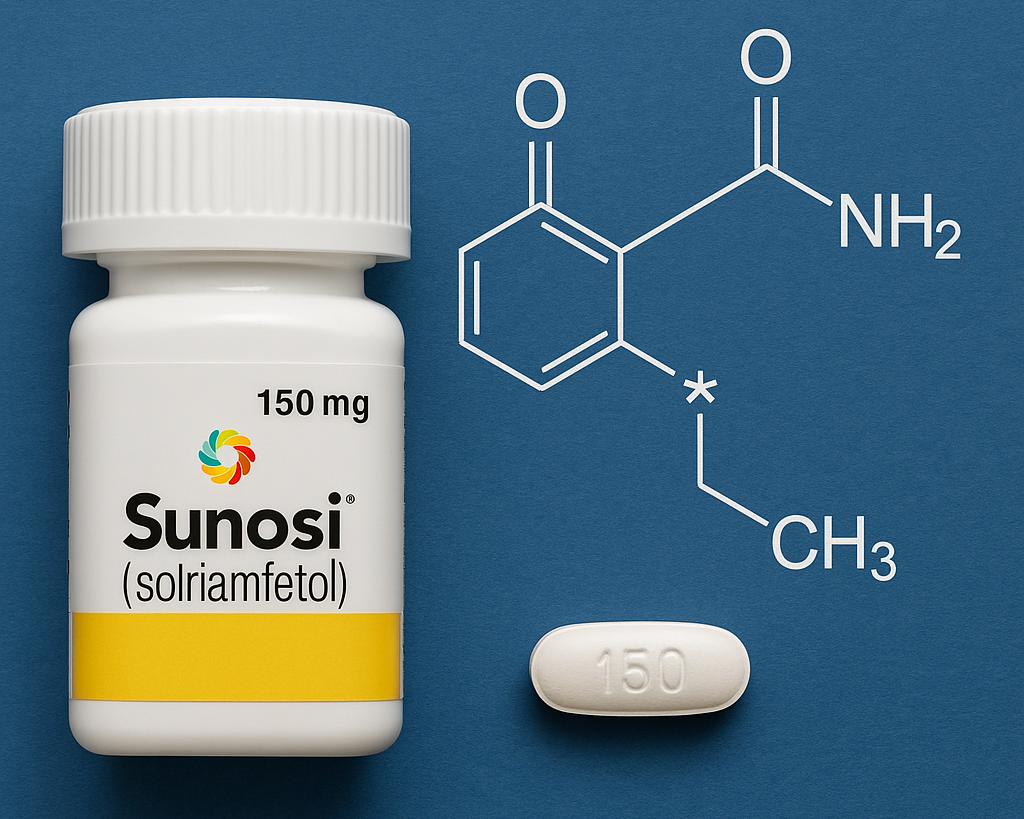Solriamfetol, sold under the brand name Sunosi, is a relatively new medication approved for the treatment of excessive daytime sleepiness (EDS) associated with narcolepsy and obstructive sleep apnea (OSA). Introduced in the U.S. in 2019 by Jazz Pharmaceuticals, Solriamfetol represents a distinct class of wake-promoting agents that stands apart from traditional stimulants and older eugeroics like modafinil.
With its unique dual action on dopamine and norepinephrine reuptake inhibition, Solriamfetol has quickly gained recognition for its potent wakefulness effects, long duration of action, and low abuse potential — making it a promising option for those struggling with debilitating sleepiness.
Pharmacological Profile of Solriamfetol
Mechanism of Action
Solriamfetol works as a dopamine and norepinephrine reuptake inhibitor (DNRI). Unlike amphetamines, it does not promote neurotransmitter release but instead increases extracellular dopamine and norepinephrine levels by preventing their reabsorption into presynaptic neurons.
This mechanism gives it:
- A cleaner stimulant profile
- Lower risk of dependency
- A gradual onset and offset, reducing the “crash” effect seen with traditional stimulants
Chemical Class
- Solriamfetol is structurally related to phenylpropanolamine, a compound once used as a decongestant and appetite suppressant.
- It is not a controlled substance in most jurisdictions (e.g., U.S. Schedule IV), reflecting its lower abuse risk compared to amphetamines.
Clinical Uses of Solriamfetol
1. Narcolepsy
- Solriamfetol has been approved for type 1 and type 2 narcolepsy, significantly improving wakefulness throughout the day.
- Studies show improvements in Epworth Sleepiness Scale (ESS) and Maintenance of Wakefulness Test (MWT) scores.
2. Obstructive Sleep Apnea (OSA)–Related Sleepiness
- Even after treating OSA with CPAP or other interventions, many patients continue to suffer from EDS. Solriamfetol is one of the few drugs approved to address this residual symptom.
- Does not treat airway obstruction, only the resulting fatigue.
Dosage and Administration
| Condition | Typical Starting Dose | Maximum Dose |
|---|---|---|
| Narcolepsy | 75 mg once daily | 150 mg daily |
| Obstructive Sleep Apnea | 37.5–75 mg once daily | 150 mg daily |
- Should be taken once daily in the morning, with or without food
- Onset of action: Within 1 hour
- Duration: Up to 9 hours
Advantages Over Other Wakefulness Agents
| Feature | Solriamfetol | Modafinil/Armodafinil | Amphetamines (e.g., Adderall) |
|---|---|---|---|
| Schedule | IV | IV | II |
| Abuse Potential | Low | Low | High |
| Half-Life | ~7–9 hours | 12–15 hours | 8–12 hours |
| Onset of Action | Fast (1 hr) | Moderate (2–3 hrs) | Fast |
| Crash or Rebound Fatigue | Minimal | Minimal | Often severe |
| Cardiovascular Effects | Mild–Moderate | Low | High |
Takeaway: Solriamfetol offers a middle ground — stronger than modafinil, safer than amphetamines.
Side Effects and Warnings
Common Side Effects
- Headache
- Insomnia
- Anxiety or nervousness
- Nausea
- Decreased appetite
- Elevated blood pressure
Caution
- Not recommended for patients with uncontrolled hypertension
- Can worsen anxiety or agitation
- May interfere with sleep if taken late in the day
Legal Status of Solriamfetol
- United States: Schedule IV (controlled, but lower risk)
- European Union: Approved under the name Sunosi
- Canada & Australia: Approved for narcolepsy and OSA-related sleepiness
- Hong Kong and Asia: Access may vary and generally requires a prescription or specialist recommendation
Solriamfetol Experiences and Reviews
According to anecdotal reports and post-market reviews:
- Users with narcolepsy often report improved wakefulness and reduced sleep attacks, especially compared to modafinil.
- Some complain of jitteriness or anxiety, especially at higher doses.
- Athletes and professionals occasionally seek solriamfetol off-label for productivity — though this is not medically advised and can be legally restricted.
“Solriamfetol feels cleaner than Adderall and doesn’t make me crash at 3 p.m. I finally feel awake during meetings.”
– Patient with OSA, Reddit user
Off-Label and Experimental Use
Although not widely promoted for off-label use, Solriamfetol is being explored for:
- ADHD (in clinical trials)
- Fatigue in multiple sclerosis (MS)
- Shift work sleep disorder
- Post-COVID fatigue (investigational use)
Note: Off-label use should always be discussed with a licensed physician.
Final Thoughts
Solriamfetol is a promising next-generation eugeroic, combining effectiveness, safety, and convenience in a once-daily pill. While it may not completely replace older agents like modafinil or amphetamines, it offers a valuable alternative — particularly for patients with persistent daytime fatigue who want a non-amphetamine solution.
As more research emerges, Solriamfetol may become a mainstay treatment not just for narcolepsy and OSA, but for broader conditions involving fatigue and cognitive performance deficits.
